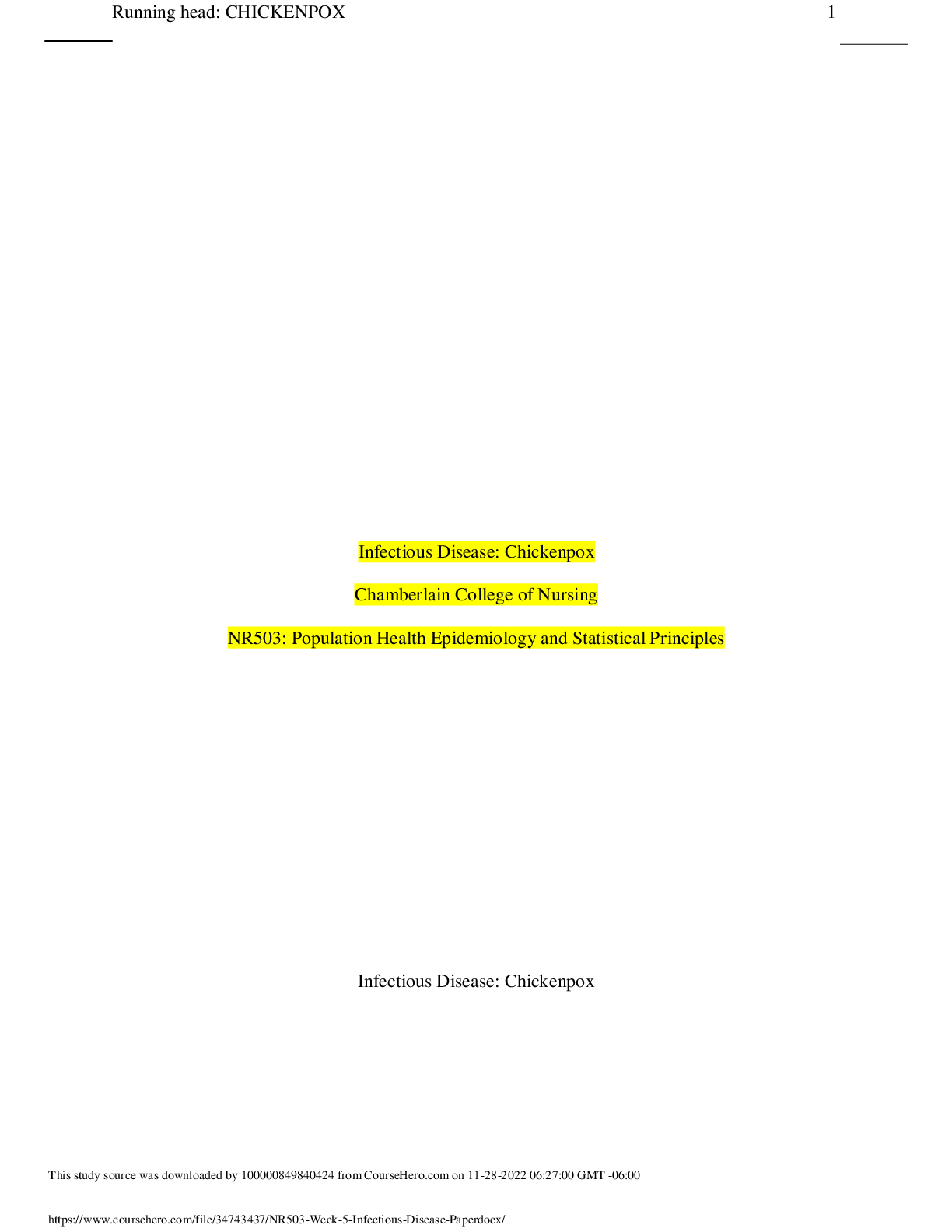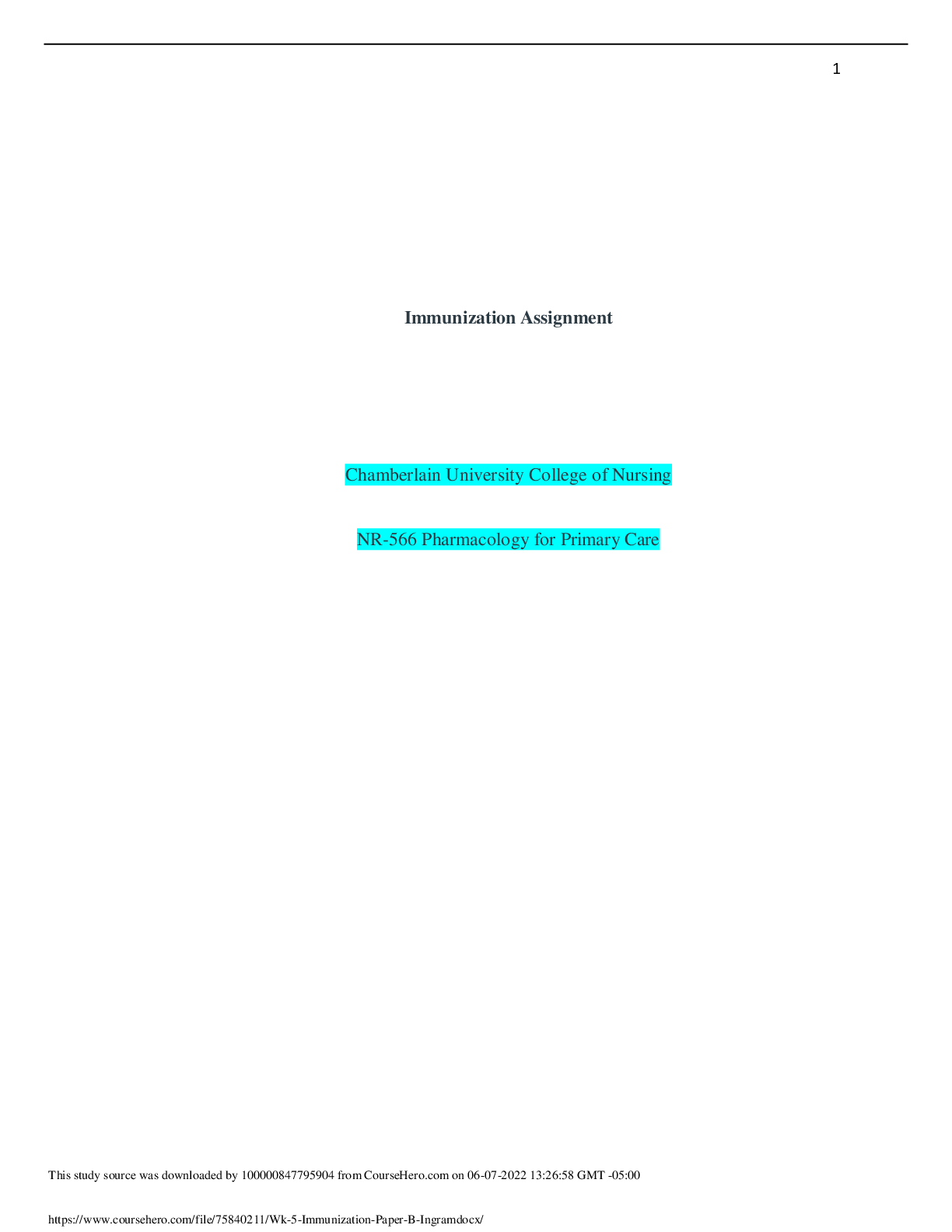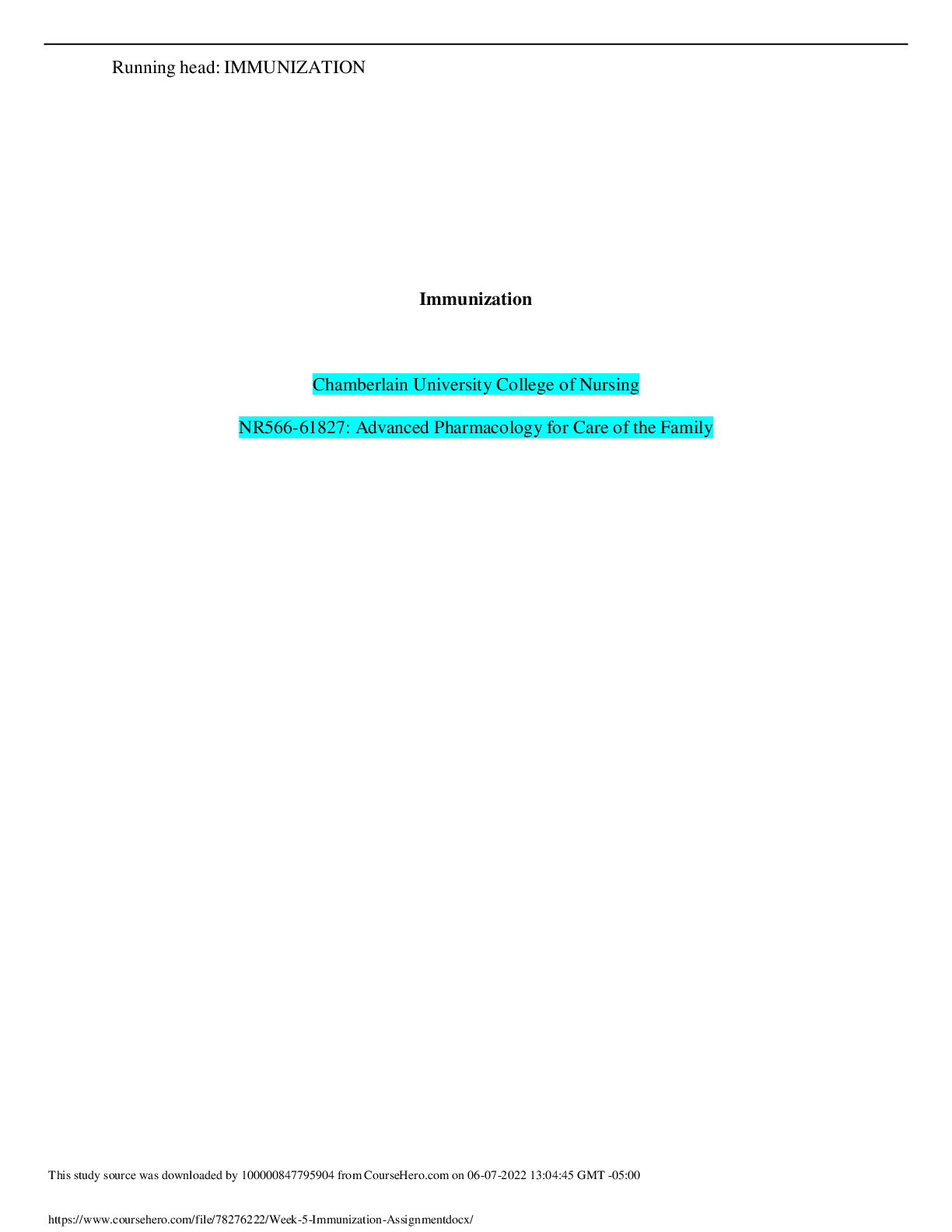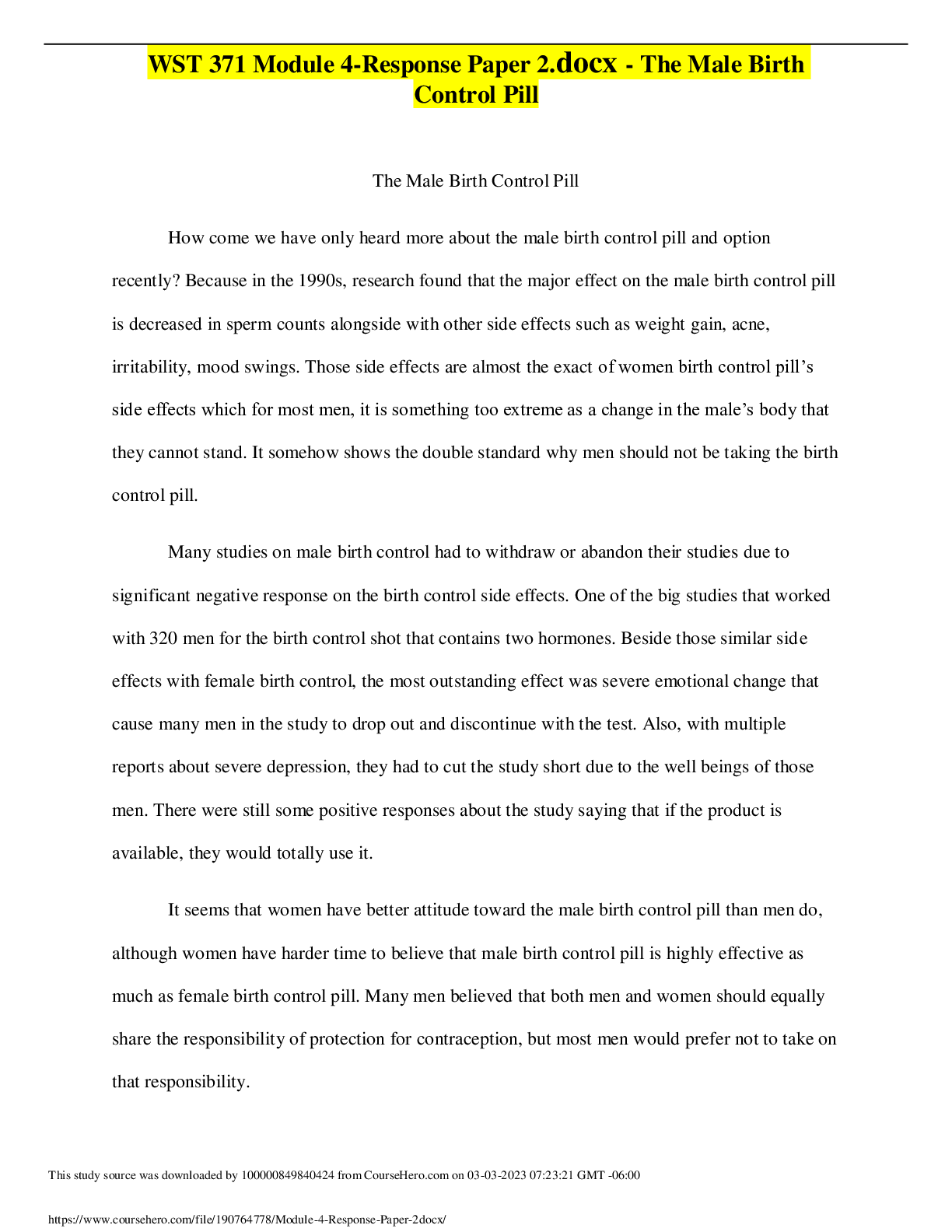*NURSING > ESSAY > NR 509 Week 3 Alternate Writing Assignment: Neurological System | Highly Rated ESSAY. (All)
NR 509 Week 3 Alternate Writing Assignment: Neurological System | Highly Rated ESSAY.
Document Content and Description Below
Alternative Writing Assignment: The Nervous System Chamberlain College of Nursing NUR 509: Advanced Physical Assessment The Nervous System While all porti... ons of physical assessments play important roles in the overall health of a patient, the neurological assessment plays a vital role that affects all systems in some shape or form by acting as a communication avenue for the entire body. Completing a neuro assessment involves the nervous system which is a very complex and involved system. “CNS testing includes complex higher functions such as gait, speech, and mental status as well as sensory and motor information” (Maher, 2016, pg. 2). When assessing the nervous system, you are not limited to one area of the body in comparison to other systems; you are responsible for assessing both from head to toe so it can be a little more time consuming. Patience and understanding is a key component in completing a thorough assessment for both the patient and the health practitioner. Structure and Function In order to evaluate the structure and function of the nervous system, you must realize it is not restricted to one generalized area of the body and it involves many different structures. When looking at the nervous system, they ultimately breakdown into two separate categories: the central nervous system and the peripheral nervous system. The central nervous system (CNS) consists of the brain and the spinal cord and the peripheral nervous system involves the nervous cells and tissue that surround the brain and spinal cord. The brain is broken into several different pieces that are each responsible for different functions of the body. The brain itself is broken down into four regions which include the cerebrum, the diencephalon, the brainstem and the cerebellum. Furthermore, the cerebral hemisphere is divided into 4 lobes: the frontal, parietal, temporal and occipital lobes. Brain tissue can either be gray or white. Some examples of gray matter includes basal ganglia, thalamus and the hypothalamus. Basal ganglia affects the bodies ability to move while the thalamus is responsible for processing sensory impulses and relays them to the cerebral cortex (Brickley, 2017). The function of the hypothalamus is to aide in maintaining homeostasis and for the regulation of temperature, heart rate and blood pressure. Furthermore, it is interconnected to the endocrine system and also responsible for emotional behaviors and sex drive. The brainstem is responsible for the connection between the brain and the spinal cord. “Consciousness relies on the interaction between intact cerebral hemispheres and a structure in the diencephalon and the upper brainstem, the reticular activating system” (Brickley, 2017, pg 714). According Brickley, the cerebellum is responsible for the coordination of all body movements and aides in maintaining the body upright (2017). The spinal cord, which is connected to the brain via the brainstem, serves as an extension from the brain in order to transmit information via signals through the nerve endings. The spinal cord is divided into the regions with sublevels which include the cervical, thoracic, lumbar, sacral and coccygeal. Injury to the spinal cord, depending on the location of the injury, can be life threatening and permanent in its effects on the human body. The peripheral nervous system involves the usage of central nervous nerves and peripheral nerves that send messages to vital organs and areas of the body including the heart, visceral organs, skin and limbs (Brickley, 2017). The peripheral nervous system involves the somatic nervous system and autonomic nervous system. Each are responsible for different mechanisms and are broken down even further with subsystems. For instance, the autonomic nervous system is responsible for the connection between the internal organ systems and the generation of autonomic reflex responses and has sub-categories of the sympathetic nervous system and the parasympathetic nervous system. The somatic nervous system controls muscle movement regulation and sensation responses. Subjective Data Collection The subjective data obtained from a neurological assessment in any patient is imperative in all patients, regardless of the patient’s initial complaint. When assessing any patient, it is important to ask the questions that might be associated with neurological disorders. According to Brickley, two of the most common symptoms associated with neurological disorders are headache and dizziness so asking about these symptoms, their severity and frequency is essential (2017). When completing a review of systems, the neurological portion of the assessment requires the provider to ask about headaches, dizziness, vertigo, weakness (generalized, proximal or distal), numbness (abnormal or absent sensation), fainting and blacking out (near syncope or syncope), speech deficits, seizures and tremors or involuntary movements. These symptoms are classified as common or concerning symptoms from a neurological symptoms. But as previously mentioned, it is important to ask about the severity and frequency of these symptoms in order to get a better idea of what might be ailing the patient. Objective Data Collection/ Assessment The basics of nursing taught us that when assessing a patient’s neurological status, we need to confirm their orientation to person, place, time and situation. Asking questions that assess their orientation allows to confirm this information but also allows the practitioner to begin to assess their speech, comprehension, vocabulary, articulation, memory and general knowledge. Through questioning, the practitioner can also assess their attention span and abstract thinking. Testing the cranial nerves through a series of different exercises is essential to a thorough neurological exam. Cranial nerve I, the olfactory nerve is examined by presenting the patient with different odors and having the patient properly identify them. Cranial nerve II, the optic nerve is tested via a visual acuity exam. Each eye is reviewed and inspected separately and again simultaneously to review for defects not excluding the pupil. Cranial nerve III, the oculomotor nerve, assesses the pupillary reaction, constriction, convergence and accommodation of the lens. Cranial nerves IV and VI, the trochlear and abducens nerves respectively, are tested by testing the extraocular movements by asking the patient to look in the six different cardinal directions and looking for the loss of movement in each eye individually. Looking at each individually while doing these exercises allows the practitioner to see jerking movements or asymmetric deviation of movements. Cranial nerve V, the trigeminal nerve, can tested for motor, corneal reflex and sensory points. The motor reflex is tested by palpation to the temporal and masseter muscles and asking the patient to clench their jaw. Through this technique, the practitioner is able to detect any asymmetrical weaknesses. The corneal reflex is examined by brushing the cornea with a fine wisp of cotton while the patient is looking away and assessing the blink response. Sensory response is tested by brushing different levels of pressure objects against various parts of the face and asking the patient to identify if the object is sharp, dull or soft. Cranial nerve VII, the facial nerve, is asking the patient to go through various facial movements. Cranial nerve VII, acoustic and vestibular nerve, is tested through conducted the Weber and Rinne tests. Cranial IX and X, the glossopharyngeal and vagus nerve respectively, is done through assessing the patient for any voice hoarseness, swallowing capabilities and testing the gag reflex. Cranial nerve XI, the spinal accessory, is tested by assessing the patient’s posterior and asking the patient shrug their shoulders against your hands and assessing for any weaknesses. The final cranial nerve XII, the hypoglossal nerve, involves listening to the patients speech and inspection of the patient’s tongue. Beyond the cranial nerve testing, there is also assessing the deep tendon reflexes. The deep tendon reflexes involves the triceps, biceps, brachioradialis, patellar tendon and Achilles tendon. Sensations in the bilateral upper and lower extremities along with grip tests are all a part of a very thorough neuro assessment to collect objective data to be used in making a diagnosis. Specific Population When assessing the pediatric population, it is important to understand that infants/toddlers will not necessarily follow the instructions and respond appropriately due to their inability to understand what is being asked of them. This is expected and therefore some questions such as those related to orientation and speech capabilities and their mobility assessment should be gauged to their age appropriately. Interviewing the young patient in comparison to the functional adult is different, however, the neuro responses to the physical portion of the exam are the same (Brickley, 2017). Assessing the elderly for a neuro assessment may produce many negative findings, however, the practitioner will realize this is just a natural regression of neuro function with increased age and not necessarily in relation to a neurological disorder. It is also important to understand that the elderly may just be slower to respond when going through interview questions and so patient is a necessity for the practitioner conducting the questioning. The pregnant women may not have the steadiest gait or a loss of equilibrium not necessarily related to a neurological disorder, but because of their rounded belly and waddling state. Stroke A common neurological disorder that affects people is a cerebrovascular accident, or commonly known as a stroke. Strokes can be classified as either ischemic or hemorrhagic with a majority of being diagnosed as ischemic. According to Brickley, strokes are the 4th leading cause of death in the US and the leading cause of long-term disability (2017). “ Ischemic stroke, the more common type, is caused by blockage of an artery in or leading to the brain by a clot or embolism” whereas “Hemorrhagic stroke floods the brain with blood when an artery in the brain leaks or ruptures, often as a result of trauma” (RainesGass & Atival, 2018, pg 1). The presentation of a stroke victim to a health practitioner can have a variety of neurological symptoms. Patients with a stroke complain of a sudden onset of symptoms that include weakness, tingling, numbness of the face, arms or legs; difficulty speaking or slurred speech, difficulty comprehending or holding a conversation, confusion, vision issues such as diplopia or light sensitivity, loss of balance or coordination, dizziness or headache. As a practitioner, it is important to recognize these symptoms because proper treatment for these patients is needed in a timely fashion in order to be effective. “Stroke outcomes improve significantly when thrombolytic therapy is given within 3 to 4.5 hours of symptom onset; however, only a minority of those suffering from a stroke reaches an emergency room within this time window” (Brickley, 2017, pg 727). For a practitioner, the patient presentation is often the clue that the patient is presenting with a stroke based on the symptoms. Sudden onset of confusion and numbness are the biggest indicators but it is confirmed with CT or MRI image testing. Some exams we can do as a practitioner to help lead us to the diagnosis is bilateral grip/strength testing, asking the patient to smile to look for the droop or sticking out their tongue. This simple things can be lifesavers should be used when assessing for a stroke. Conclusion While the neurological complete physical exam, both subjective and objective collection, can be lengthy, it is a necessity. We learned today the neurological disorders can affect various systems of the body and what might feel like a normal headache could actually be something extremely more serious in nature. Being thorough and not skipping steps is vital for every patient, every time. It is the responsibility of the healthcare provider to understand the full functionality of the nervous system and every exam in order to fully understand the human body and how we function. References Brickley, Lynne S. (2017). Bates' Guide to Physical Examination and History Taking (12th ed). Philadelphia: Wolters Kluwer Maher, A., MS, RN, FNP-BC. (2016). Neurological assessment. International Journal of Orthopaedic and Trauma Nursing, 22, 44-53. doi:10.1016/j.ijotn.2016.01.002 RainesGass, D. R. B., & Avital, O. R. B. M. (2018). Stroke: Risk Factors -- an Overview. CINAHL Nursing Guide. Retrieved from https://search-ebscohost- com.chamberlainuniversity.idm.oclc.org/login.aspx? direct=true&db=nup&AN=T702989&site=eds-live&scope=site [Show More]
Last updated: 2 years ago
Preview 1 out of 9 pages
.png)
Buy this document to get the full access instantly
Instant Download Access after purchase
Buy NowInstant download
We Accept:

Also available in bundle (1)

NR 509 ALTERNATIVE WRITING ASSIGNMENTS WEEK 1-4, 6-7 ( COLLECTION) | 100% GUARANTEED PASS.
NR 509 ALTERNATIVE WRITING ASSIGNMENTS WEEK 1-4, 6-7 ( COLLECTION) | 100% GUARANTEED PASS.
By Goodluck Academia 3 years ago
$14
5
Reviews( 0 )
$10.00
Can't find what you want? Try our AI powered Search
Document information
Connected school, study & course
About the document
Uploaded On
Nov 16, 2021
Number of pages
9
Written in
Additional information
This document has been written for:
Uploaded
Nov 16, 2021
Downloads
0
Views
80














